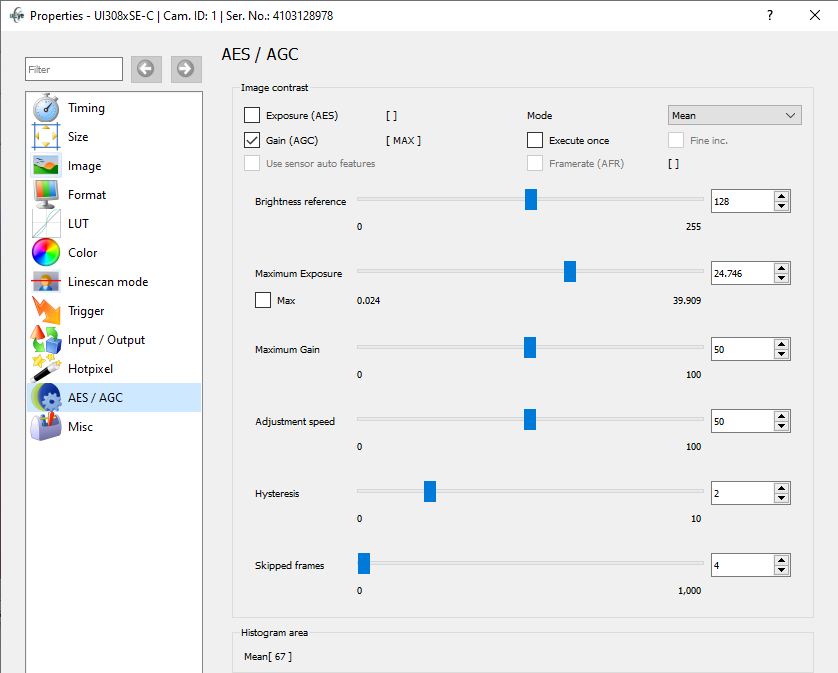IDS Software Suite 4.96.1
Under "AES/AGC", you can set parameters for automatically adjusting the exposure time and sensor gain of your uEye camera (see also Automatic image control).

Fig. 168: uEye Demo - AES/AGC
|
•Auto Exposure Shutter (AES) automatically adjusts image brightness based on the exposure shutter setting. Long exposure times may cause motion blur. •Auto Gain Control (AGC) automatically adjusts image brightness based on the hardware gain control setting of the camera sensor. You can activate this function in addition to AES if ambient light conditions are poor. High gain settings may cause artefacting. •Auto Frame Rate (AFR) adjusts the frame rate to allow longer exposure times (see also Pixel clock, frame rate and exposure time). Selecting this check box might decrease the frame rate substantially. This function is only available when AES is active. |
Image contrast
Use the following settings to configure automatic brightness control:
•Exposure (AES)
Enables automatic adjustment of image brightness, i.e. the exposure time is automatically adjusted to achieve the preset brightness reference value.
|
Note: If AES is enabled together with AGC and AFR, AES has the highest priority, i.e. AES is set first and then AGC and AFR. |
•Gain (AGC)
Enables the automatic gain, i.e. the control automatically adjusts the gain to achieve the set brightness reference value.
•Use sensor auto features
This option enables on some sensors the internal brightness adjustment.
|
The sensor's auto features are supported by the sensors of the following camera models: Please also read the notes on using these sensors. |
•Mode
Here, you select the mode for the auto control.
oMean (is_SetAutoParameter())
In mean mode, the average brightness and color rendering of the image is adjusted to the preset desired value. The setting is done using the brightness reference.
oPeak White (is_AutoParameter())
In peak mode, a reference ratio of pixels is specified in the image according to the selected mode to be controlled. The peak white mode controls to the target value of all color channels (RED|GREEN|BLUE).
oPeak Channel (is_AutoParameter())
In peak mode, a reference ratio of pixels is specified in the image according to the selected mode to be controlled. The peak channel mode controls to the target value of the dominant color channel in saturation.
|
The two modes "Peak White" and "Peak Channel" differ only for color cameras as monochrome cameras have only one color channel. |
•Execute once
The control is switched off automatically if the specified target value is reached or nearly reached, and the set value does not change after three measurements.
•Fine increment
In combination with the modes "Peak White" or "Peak Channel", it allows to set the brightness reference value in fine steps (granularity of 0.01 … 20.00 %).
•Frame rate (AFR)
Enables the frame rate control. This option is only available when AES is active.
If the maximum exposure time is not sufficient for a brighter image, you can use AFR to reduce the frame rate and so extend the exposure time.
•Brightness reference
Defines the target value which should be set. Under normal conditions and in "Mean" mode, a reference value of 128 is sufficient. In the mode "Peak White" or "Peak Channel", you enter the desired quantity of white pixel in the image via the brightness reference (value range: 1-20 %). In combination with the "Fine inc" option, you can set fine increments.
•Maximum exposure
Sets the upper limit for the exposure time. This upper limit is not exceeded if AES is enabled. If AES and AFR is enabled then the upper limit is ignored.
•Maximum gain
Sets the maximum gain limit. This upper limit is not exceeded when AGC is enabled.
•Adjustment speed
Sets the adjustment speed. The higher the speed control is set, the faster the adjustment is. Setting the speed control to 0 disables the adjustment functionality. If the value is set to high the adjustment starts to oscillate. In this case you have to reduce the adjustment speed.
•Hysteresis
Defines the difference by which the actual value can differ from the target value. If the target value is set e.g. to 128 and the hysteresis is set to 2, so there will be no regulation as long as the actual value is between 126 and 130 (see also Automatic image control: Hysteresis).
If the value for hysteresis is too small, the adjustment starts to oscillate. It is recommended to keep the standard value of 2.
•Skipped frames
Number of frames that will be skipped during automatic image control when freerun mode is active (see also Automatic image control: Control speed). The higher the frame rate, the higher the value should be. If the value is too small, the adjustment may starts to oscillate, or there is an overload of the system. In this case increase the value.
Histogram area
The histogram area specifies which area of the image will be used for calculating the average grayscale value of the image.
You can set the size of the histogram area by using the tools on the toolbar.
Resetting the parameters
Click on the "Default" button to reset all parameters to the model-specific defaults.
